





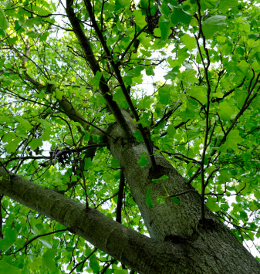 Sweet gum tree has a breathtakingly beautiful fall foliage color that serves to be its crowning glory. Gardening enthusiasts would be glad to welcome and beseech the fantastic fuchsia to adorn their garden decor. It is truly an ornamental cultivators pride to lay hands on sweet gum tree, and plant it in his garden to make a landscape design worth innumerable peans and aplomb.Facts► Sweet gum tree is also referred to as star-leaved gum, alligator wood, red gum, and gum tree.
Sweet gum tree has a breathtakingly beautiful fall foliage color that serves to be its crowning glory. Gardening enthusiasts would be glad to welcome and beseech the fantastic fuchsia to adorn their garden decor. It is truly an ornamental cultivators pride to lay hands on sweet gum tree, and plant it in his garden to make a landscape design worth innumerable peans and aplomb.Facts► Sweet gum tree is also referred to as star-leaved gum, alligator wood, red gum, and gum tree.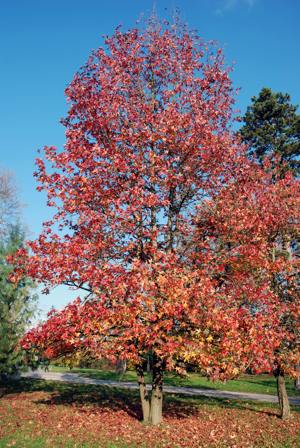 ► The tree is an active member of the flowering plant. It hails from the Altingiaceae family tree, belonging to the Saxifragales order.► In scientific nomenclature, the sweet gum tree is called Liquidambar styraciflua. This name was derived from the tree's innate property of secreting a resin-like substance.► It thrives well in both acidic soil and alkaline soil, and ponds and streams are its predominant areas.► The tree ranges between 80 to 150 feet in height.
► The tree is an active member of the flowering plant. It hails from the Altingiaceae family tree, belonging to the Saxifragales order.► In scientific nomenclature, the sweet gum tree is called Liquidambar styraciflua. This name was derived from the tree's innate property of secreting a resin-like substance.► It thrives well in both acidic soil and alkaline soil, and ponds and streams are its predominant areas.► The tree ranges between 80 to 150 feet in height.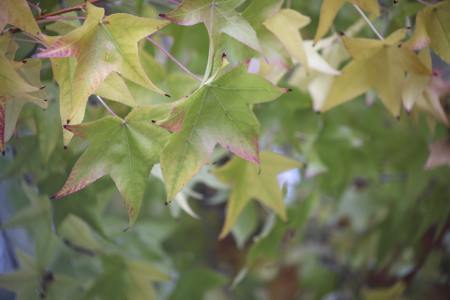 ► It is a large deciduous tree that has a beautiful leaf pattern. They are star-shaped and have palm-shaped lobes. The leaves are arranged in an alternating structure. The leaves are a shade of dark green at the top, getting lighter in hue when receding through the length of the leaf. The leaves emit a foul smell if crushed or damaged.
► It is a large deciduous tree that has a beautiful leaf pattern. They are star-shaped and have palm-shaped lobes. The leaves are arranged in an alternating structure. The leaves are a shade of dark green at the top, getting lighter in hue when receding through the length of the leaf. The leaves emit a foul smell if crushed or damaged.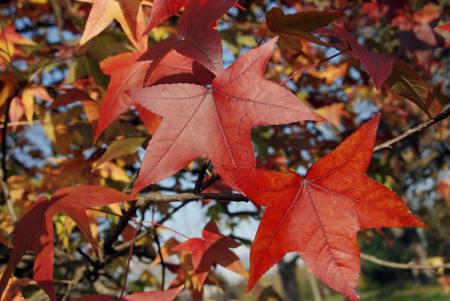 ► During autumn, the leaves change their hue to puce red, pulpy orange, sunny yellow, or fuchsia purple.
► During autumn, the leaves change their hue to puce red, pulpy orange, sunny yellow, or fuchsia purple.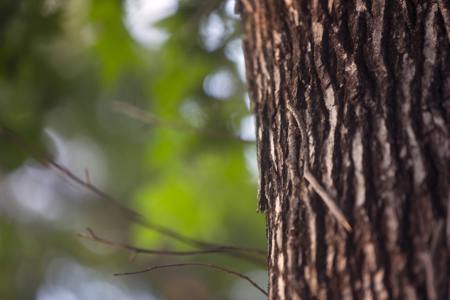 ► Coincidentally, the bark emits a gum-like substance that is used in making chewing gum. The bark is gray in color and has a scaly skin. After a passage of two years, the barks adorn three to four twig-like projections that gives the size of the tree a sufficient boost.
► Coincidentally, the bark emits a gum-like substance that is used in making chewing gum. The bark is gray in color and has a scaly skin. After a passage of two years, the barks adorn three to four twig-like projections that gives the size of the tree a sufficient boost.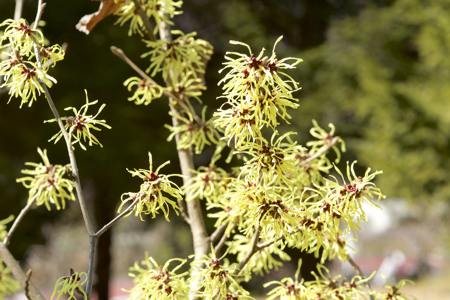 ► The flowers are monecious, i.e., the tree consists the male and female reproductive organ in concert. The flowers are enveloped in brown-colored fur. Stamens are ensconced aplenty with the anther (containing pollen) bent in an upward direction.
► The flowers are monecious, i.e., the tree consists the male and female reproductive organ in concert. The flowers are enveloped in brown-colored fur. Stamens are ensconced aplenty with the anther (containing pollen) bent in an upward direction.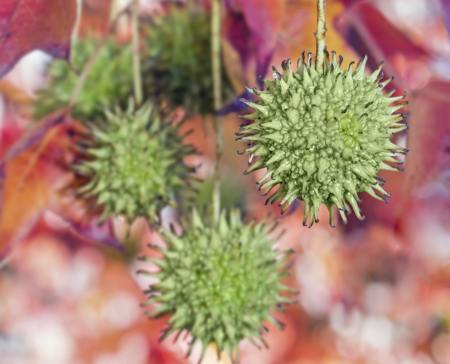 ► It yields compound fruits that are referred to as monkey balls or gum-balls.► They are round in shape, with a dry and rough appearance. The gum balls or monkey balls are said to have several capsule-like structures, wood-like in appearance.► The uses of the tree extend from structuring furniture to using it as an ornamental tree for the purpose of landscaping. The sweet gum wood is also used for fabricating veneers, flooring, and making decorative baskets.Clean UpThe question on how to pick up sweet gum tree monkey balls remains a mystery for all those who have racked their brains over and over again. Well, there are no effective tools and equipment that propose to help you in picking up the gum balls. It is always sensible to use your hands and pick them up. You may use a raking machine to get rid of them, but why bother the tool when you just have a few to gather from the area. Continuing with the routine of picking up the balls once in a week is the easiest way of getting rid of these balls and keeping your yard clean. You could also resort to keeping your garden beds looking fuller by the day, by adding the gum balls to the mulch. They are not prone to rotting too soon and have the ability to cover the garden beds cleverly. They could also be used for the purpose of providing a landscape design to make your garden look well endowed. All you need to do is to add the gum balls to the bottom layer of the soil. As they do not rot quickly, they might as well, remain there and add up to the layers of the soil.Besides, the sweet gum balls can also be used in creating crafts. You could use the gum balls as beads and string them together to lend a primitive look to your room, or employ them in any endeavor that requires you to activate your creative quotient.
► It yields compound fruits that are referred to as monkey balls or gum-balls.► They are round in shape, with a dry and rough appearance. The gum balls or monkey balls are said to have several capsule-like structures, wood-like in appearance.► The uses of the tree extend from structuring furniture to using it as an ornamental tree for the purpose of landscaping. The sweet gum wood is also used for fabricating veneers, flooring, and making decorative baskets.Clean UpThe question on how to pick up sweet gum tree monkey balls remains a mystery for all those who have racked their brains over and over again. Well, there are no effective tools and equipment that propose to help you in picking up the gum balls. It is always sensible to use your hands and pick them up. You may use a raking machine to get rid of them, but why bother the tool when you just have a few to gather from the area. Continuing with the routine of picking up the balls once in a week is the easiest way of getting rid of these balls and keeping your yard clean. You could also resort to keeping your garden beds looking fuller by the day, by adding the gum balls to the mulch. They are not prone to rotting too soon and have the ability to cover the garden beds cleverly. They could also be used for the purpose of providing a landscape design to make your garden look well endowed. All you need to do is to add the gum balls to the bottom layer of the soil. As they do not rot quickly, they might as well, remain there and add up to the layers of the soil.Besides, the sweet gum balls can also be used in creating crafts. You could use the gum balls as beads and string them together to lend a primitive look to your room, or employ them in any endeavor that requires you to activate your creative quotient.
Copyright © www.100flowers.win Botanic Garden All Rights Reserved